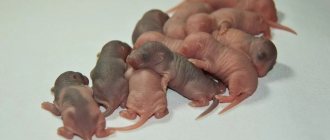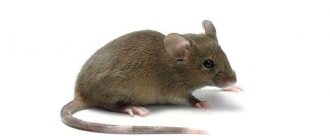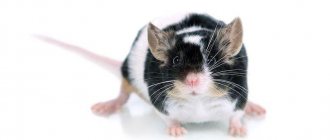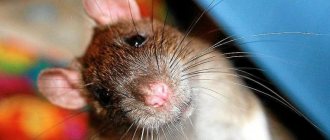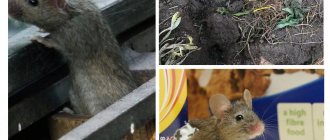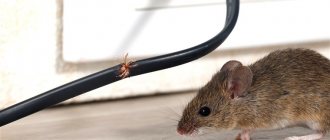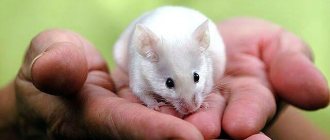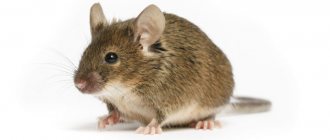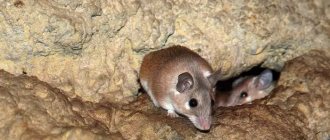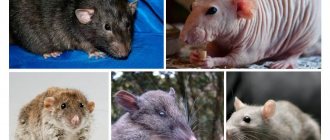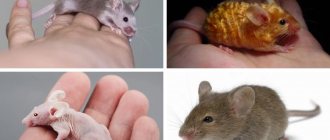Mice and rats belong to the group of cosmopolitan species, which implies a wide distribution area of these mammals, which live in all corners of the planet, with the exception of mountainous areas and zones of the Far North.
Both of these species are characterized as synanthropic, that is, even wild members of the family live near human habitation, which facilitates access to food sources. Most people believe that the only difference between rats and mice is the difference in size. This is true, rats are large, but there are other differences that are worth considering in detail.
What are the differences
A mouse and a rat have similar external characteristics. The main ones are: a pointed muzzle, the absence of thick hair on the tail, and the presence of sharp incisors that continue to grow throughout the life of the rodent.
But despite belonging to the same family and the presence of a number of external similarities, there is a difference between rats and mice
Differences between a mouse and a rat
To distinguish a mouse from a rat, you can consider not only an adult animal, but also a small representative of the species. Newborn rodents also have a number of external and behavioral characteristics inherent in representatives of a separate species.
The main differences between a baby rat and a mouse are:
- The difference between a rat and a mouse is the size of the tail. In the former, its length can be up to 110 percent of the body size, while the mice have a shortened tail, the size of which is no more than 60 percent of the body length.
- Small rodents have a round and less pointed head.
- To distinguish a rat from a certain mouse, you can look at its behavior. Small rodents prefer to eat, sit or sleep, huddled in a ball, while when gathering they behave freely.
The differences between mice and rats also lie in the characteristics of their fur : in small rodents it is softer and less dense.
Video
Funny animals. Mice and rats.
The main differences between domesticated rats and mice
Decorative rodents are widely popular as pets; they are clean, unpretentious, and do not require complex care.
The differences between domesticated rats and mice are as follows::
- The chromosome set of small rodents includes twenty-two chromosomes, while their large counterparts have only twenty. This feature makes it impossible to cross representatives of different species with the aim of subsequently producing offspring.
- Domestic rodents have a large body, the length of which is more than twenty centimeters, and the weight can reach six hundred grams.
- There are also external differences: the ears of small rodents are soft, rolled into peculiar little bags, while the ears of rats are dense and pointed.
- The body of small rodents is round, while large ones are long and elongated.
The lifespan of wild mice is no more than one and a half to two years. Domesticated rats, if cared for in accordance with the rules, live longer - up to three to four years.
Differences in intelligence
The main difference between a rat and a mouse is the level of intellectual ability. Large rodents, wild and domesticated, have remarkable intelligence.
They are careful, cunning, smart . It is extremely rare that these representatives of the rodent family fall into traps, and if this happens, the unlucky individual transmits a signal to the rest of the colony, thanks to which others will avoid the dangerous place.
Unlike mice, decorative rats are easy to train, they know their nickname and respond to it, they come up with games, attracting the owner to participate. They are sociable and love to spend time with people.
These unpretentious pets can be called companions. When buying a pet, you need to take into account its age, health, and habits of the animal.
Differences in nutrition
Mice and rats are omnivores. Their diet consists of cereals and vegetables, but at the same time they will not give up meat. Wild mammals have a peculiarity - they hunt in a whole flock, choosing as prey animals that significantly exceed them in size and body weight. This behavior is not typical for mice.
During periods of hunger, animals can feed on leather, paper, soap, and other organic matter, which determines a high level of survivability. These are synanthropic mammals that prefer to settle closer to human habitation, which makes it easier for them to access food sources.
When choosing food, animals may refuse poisoned grains or seeds, which is due to the presence of a keen sense of smell.
Who is stronger
Based on the above, we can draw logical conclusions about who is stronger, a mouse or a rat: rodents with greater body mass and size exceed their smaller counterparts in strength. Separately, it is necessary to say about the intellectual level of these animals.
Due to the presence of good mental abilities and living in a large family, rats multiply quickly, increasing the size of the colony in record time.
How are the tracks different?
Traces left by rodents also have significant differences, which are as follows::
- During a jump, the distance between the tracks of small animals is thirty centimeters. The jump length of large rodents is much longer, reaching one and a half meters.
- When moving, small mammals push off with their hind legs, while leaning on their front legs. Accordingly, the footprints resemble a trapezoid. Behind the trail you can clearly see the line left by the long tail.
- The size of the rat's front paws is two by one and a half centimeters, the rear paws are four centimeters in diameter. When an animal moves quickly, prints remain, the distance between which can be up to one and a half meters. If an animal moves at a leisurely pace, a characteristic thin chain of clear tracks remains on the wet ground or snow.
It is almost impossible to confuse the tracks left by animals, since rat prints are massive in size.
Animal behavior
Mice in the house crawl out of their holes only when there is complete silence. If a slight rustle occurs, they try to move away unnoticed as much as possible. When a house is found, the whole family moves in there without first examining the territory. Due to the more primitive structure of the brain, they fall into simple mousetraps, and in many cases cannot recognize the poison used against them by humans. They move directly.
Rats always search the area first. Seeing a person, they are in no hurry to hide, they think over a safe route of retreat, and not finding him, they attack the enemy, biting the neck, and if such a bite is impossible, the limbs. The more adults die, the more babies are born to the remaining ones.
If you fail to catch a rodent, you should pay attention to the traces it leaves. The paw prints left by rats are quite clear and rare because they move by jumping
As for the tracks left by mice, they are more frequent. A careful inspection of the lower part of the walls will help you identify the uninvited guest.
When rats move, they press against the surface, leaving abrasions. Mice are more careful in this regard, so there are no characteristic marks left behind. Pasyuk is a rather aggressive creature that can attack a person if it feels that his life is in danger, which cannot be said about the practically harmless mouse, which often runs away at the sight of a person.
The house mouse is one of the most common species of mammals, whose life is closely related to humans.
In terms of mental development, a rat is significantly superior to a mouse. Some people even compare large rodents to dogs and cats. They are more careful and discerning. When choosing a new place to settle, Pasyuks first explore the territory to make sure it is safe. Because of this quality, it is quite difficult to get rid of rats using various poisons.
We suggest you read: How to get rid of rats in a chicken coop forever
What they look like
The difference between large and small representatives of the family is especially noticeable if each parameter of the animals’ external appearance is assessed separately.
Rats and mice look like this::
- Dimensions. The body length of large animals can be about thirty centimeters, while the length of the average mouse does not exceed ten centimeters.
- Mouse eyes are larger than rat eyes.
- Rat tails are longer, more massive at the base, and completely devoid of hair, while mice have hair.
- Rat muzzles are elongated and oblong.
The color of animal fur can vary depending on the species. Decorative rodents have different color options, with white and black colors being common.
Intelligence
The mental abilities of these two representatives of the mouse family are also very different. According to scientists, rats are intellectually developed creatures.
- Firstly, they will not settle in places that are potentially dangerous for them.
- Secondly, they always examine the future home and assess the situation.
- Thirdly, they create entire communities with their own hierarchy and laws.
Norushki are more reckless in this regard, and therefore it is much easier to fight them, since you can easily deceive or outwit.
Similarity in appearance
Mice and rats, despite belonging to separate species, have a number of similar characteristics.
These include:
- Lack of thick hair on the tail. The exception is the black rat; the tail of this animal is covered with thick hair.
- Round eyes black.
- Presence of sharp anterior incisors.
Similarities can also be identified according to the characteristics of behavior, nutrition, and lifestyle in general.
What do rats and mice have in common?
These mammals belong to the order of rodents of the mouse family. There are other common features. Because of them, these two species are often confused.
Mice and rats: general features of life
Both of them belong to cosmopolitan species. That is, these rodents inhabit all corners of the Earth except Antarctica and the Far North, and they are not found high in the mountains.
These rodents are considered synanthropic, that is, associated with humans. Wild subspecies live in human homes, utility rooms or those intended for keeping pets. Although in warm regions they can live far from human habitation.
Rodents are animals with a nocturnal and twilight lifestyle. They are most active at sunset. However, when kept in captivity, animals adapt to the rhythm of life of the owner, get used to staying awake in the light and reducing activity during human rest.
These types of rodents are very active. They climb, run, jump and swim beautifully. Possessing high plasticity of the body, the animals can “leak” into very small crevices.
In nature, mice prefer to live in colonies in which they maintain a hierarchy. Adult males can start fights among themselves. In families, aggression sometimes spreads to older offspring, which the parents expel from their territory.
Rodents are clean creatures. They keep their homes clean and tidy. The droppings and piles of dust held together by urine that they leave while moving are special marks for determining the route.
Both types of rodents not only live in nature, but also take root in captivity and are easily tamed. Today, breeders have developed domesticated subspecies of various colors, which many fanciers are happy to keep as companion animals.
Similarity in appearance
The mouse really looks like a smaller copy of a rat:
- House mice and rats have long tails covered with horny scales and sparse short hairs. Only the black rat stands out here. Her tail is covered with thick hair.
- Both species have a sharp muzzle, small round ears, and round black eyes (in albinos they are red or dark ruby).
- The main characteristics of these two types of rodents are long, sharp incisors that grow throughout their lives and the absence of fangs. With their teeth, animals can gnaw through very hard materials, even concrete.
Important! Keeping in mind the characteristics of the teeth of these rodents, when keeping animals, it is necessary to give them the opportunity to grind down their incisors. To do this, pets are given twigs with a diameter of 2-4 cm and pieces of charcoal in their cages.
How to determine the type of spoiled food
You can also distinguish a mouse from a rat by the type of spoiled food.
If there are rodents in the house, you can determine their species according to the following behavioral characteristics:
- Cereals. When eating cereals, rats consume the grains without leaving any traces behind. Mice leave behind husks and spoiled grains.
- Small representatives of the family prefer to eat in only one place, while large ones cause serious damage to the household and food supplies, choosing new food sources each time.
If rodents have settled in the house, it is important to be able to determine their species, since control methods differ. To exterminate mice, you need to choose a trap or insecticides; to remove large rodents, you need to call professional exterminators, since these animals are extremely careful, cunning, and smart.
Younger age
Starting from the fourth day, the development of little rat pups occurs at a rapid pace.
- 4th day the ears open, the pups begin to distinguish sounds and hear rustling sounds;
- 6th body is covered with soft dark fluff;
- On the 8th, teeth emerge, except for the main incisors.
After 10 days of life, the pups become active. They crawl well and master the terrain. If these are pets, they should be handled more often so that the animals grow up tame. However, during the game they should not be left unattended, since coordination of movements is not yet developed, the kids can fall to the floor from a table, any height.
Habitat
This rodent can take root almost anywhere: in a field, in a meadow, in a forest. The only criterion for the area inhabited by baby mice is the abundance of grass, and it is desirable that it be tall. In it, a mouse can build a nest and feed itself. The nests of these animals are spherical and look like a real work of art. The little ones love to climb the stems of plants, which is not particularly difficult for them, because they weigh very little, and they also have a very tenacious tail.
Pregnancy
Pregnancy in mice is indicated by the absence of another estrus. An attentive owner will definitely notice changes in the behavior of the rodent while bearing cubs. Some animals become calmer, others, on the contrary, become irritable or even aggressive.
Until almost the middle of pregnancy, it is impossible to determine that the mouse is carrying cubs in the womb. The rodent looks normal except for the fact that its appetite is slightly increased. The mouse walks smoothly and carefully. Motor activity decreases slightly. In the second half of the term, the abdomen increases in size. Shortly before birth, you can feel the fruit inside.
During pregnancy, mice experience toxicosis:
- the female loses her appetite;
- looks lethargic;
- eyelids drooping;
- drool flows from the mouth;
- sometimes there are cramps.
Important! Toxicosis cannot be treated. A mouse that bears offspring needs to be provided with complete rest, since the main cause of this pathology is stress.
How many babies does a mouse carry?
The gestation period in mice lasts 18-24 days. The duration of gestation depends on how many cubs are in the womb. The greater the number of pups, the faster the birth will begin. The length of gestation can also be affected by the conditions under which the rodent is kept.
In a favorable environment and with good nutrition, the mouse waits 20-22 days for the birth of its cubs.
Caring for a pregnant mouse
From the home of the mouse that carries the cubs, everything unnecessary is removed - the wheel, the tunnels. Access to the second level is limited.
About 10-12 days before giving birth, the mouse begins to build a nest. To do this, she will need pieces of fabric, napkins and paper. The rodent carries all this into the house. If until now the animal did not have a private place in the cage, the owner must equip it. It is there that the mouse gives birth to her pups and takes care of them.
The temperature and humidity in the room should remain approximately the same level. Do not disturb the mouse unnecessarily. Even cleaning the cage during pregnancy is done less often than usual. No noise or contact with other animals is allowed.
Despite the fact that the mouse needs rest, motor activity is not limited. The expectant mother is not prohibited from walking outside the cage, but only under the supervision of the owner.
5-6 days before the birth of the cubs, you need to do a general cleaning of the mouse’s home. All equipment and trays are thoroughly washed and disinfected with boiling water. It is better not to touch the nest if the female has already managed to equip it. If the male was still in the cage with the pregnant mouse, he should be removed.
If this is not done, he can impregnate the female within a few hours after birth.
Feeding
In the first half of the gestation period, the mouse's daily food intake is increased by a third, and in the second half, it is doubled. In addition to the grain mixture, the female should receive vegetables, fruits and fresh herbs. Since calcium and protein are needed for the development of cubs, low-fat cottage cheese, eggs and milk are introduced into the diet.
A glucose solution is added to drinking water. There should be a lick stone in the cage, with the help of which the mouse satisfies the increased need for minerals.
Childbirth
Before the expected date of birth, the mouse cage must be washed and disinfected, and fresh hay must be placed in its nest. Mice are born mainly at night, and the process itself can take two hours.
On a note!
Beginners in breeding are often concerned with the question of how many mice are born at one time. A well-cared-for female can give birth to many babies - about 14. But on average, she can give birth to 5-9 mice.
The owner is notified of the completion of the birth by the squeak of the cubs. You should not touch the mice right away. The mother may not like the foreign smell, and she will abandon the offspring or kill them. But it is necessary to remove the stillborns.
If contractions do not occur on the expected day of birth, you should not contact the veterinary clinic for help. You need to monitor the condition of the mouse. A healthy female behaves as follows:
- she eats well;
- actively moves;
- the fur and eyes are shiny.
You should panic if contractions go on for a long time (10-15 minutes) and there are no babies. In this case, you need to call a veterinarian.
Babies are born naked, with their ears and eyes closed.
Rodent breeders should know how mice reproduce. This way you will be able to get strong offspring and maintain the health of the female. Ornamental babies may experience complications during childbirth, which a doctor can handle.
How many babies does a mouse have? We rarely ask ourselves this question, although we guess that they multiply quite quickly.
Amazing moments from the life of rodents
Facts about rats Interesting facts about rats are regularly published in the press around the world. An experiment was carried out. Several wild rats from the same family were placed in a glass container. One of them was placed in another box side by side. They threw food at her, but when the animal began to eat, her other relatives were shocked. The animal saw all this suffering through the glass. As a result, 90% of individuals chose their own death and refused to eat.
A lot of interesting:
- From whom rats originated, there are many versions. Some believe that these are space aliens transmitting signals to distant worlds. The fact confirms that animals arose 48 million years earlier than humans. But they could have happened in the process of evolution.
- The joints of rats have the same structure as human ones, with an equal number of bones.
- Gray rats or pasyuki develop speeds of up to 10 km per hour, jump in a calm state up to 80 cm in height, and when aggressive - up to 200 cm in height and length. Pasyuk can swim on water for 3 days. The recorded record is a distance of 30 km. If there is no way to get to land, he will drown.
- Rats squeak in the ultrasonic range, remaining invisible to predators. They communicate with each other, warn about danger, about finding food.
- The rat is the only mammal that can laugh. Scientists recorded the animal's smile while showing a funny video. It has been established that these rodents dream.
- During a mass extinction event, rats are not in danger of becoming extinct. The number is regulated by nature due to the increase in rat pups in one litter. A pair of rats can reproduce about 2 thousand rat pups in a year, creating their own numerous colony with a leader and several dominant females.
- There is a version that rats caused the extinction of dinosaurs. They regularly sucked out the eggs, preventing the young from developing. The number of rats in the world is such that there are 2 rodents per person. In those days the colonies were just as numerous.
- In a year, one individual is capable of devouring 12 kg of various food, the damage from spoilage of supplies and containers is several times greater.
You can endlessly cite interesting facts from the life of rats. For these reasons, these animals are preferred to dogs, cats, and kept as pets. Translated from Chinese, the word “rat” means happiness.
Varieties
Brownies. This is facilitated by high adaptive capacity. The animals tolerate cold and heat relatively well and adapt to any living conditions. Close proximity to humans ensures survivability - a minimum of enemies, a large amount of food. A typical representative of mice can be found outdoors and indoors. Lives in garages.
House mice are the most common experimental specimens in laboratories. Over many years of work, breeders have intentionally or unintentionally bred many different subspecies of house mice. But several have been officially identified.
House mouse classification:
- musculus – has become widespread in Poland, Northern and Eastern Europe, and parts of Russia;
- bactrianus - an interesting species of domestic mice found in Asia;
- domesticus - a heat-loving species found in Southern Europe, America, Africa, Australia;
- castaneus is another representative of Asia, only in the southeastern part.
For a long time, there was another species of house mice - Mmmolossinus. Rodents have become widespread in Japan. However, later scientists stated that this species cannot be classified as a separate type, since they obtained the animals by crossing Mmmusculus, Mmcastaneus.
Newborns
Rats are born deaf, blind, naked, with a short tail, and undeveloped limbs. Body pink. Seeing such a baby, it is difficult to immediately determine who his mother is and what type of rat she belongs to.
Interesting!
Initially, the weight of a newborn is no more than 6 g. However, body weight increases every day by 2-3 g, since baby rats have an excellent appetite and actively suck the nutritious milk of the female.
On the third day of life, the baby rat appears soft, dark-colored fluff on its back. The future color is already visible. From this moment the next period of the children’s life begins.
